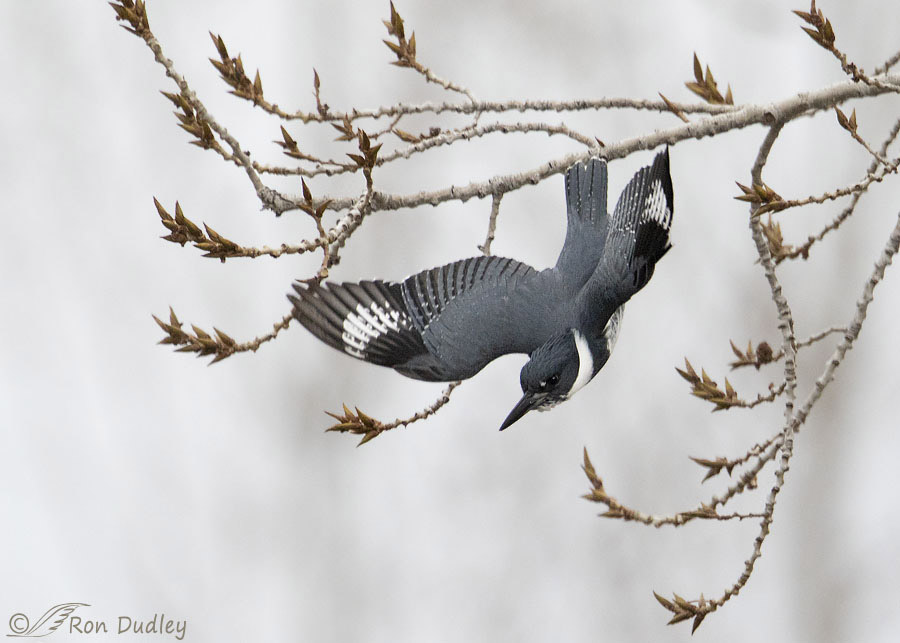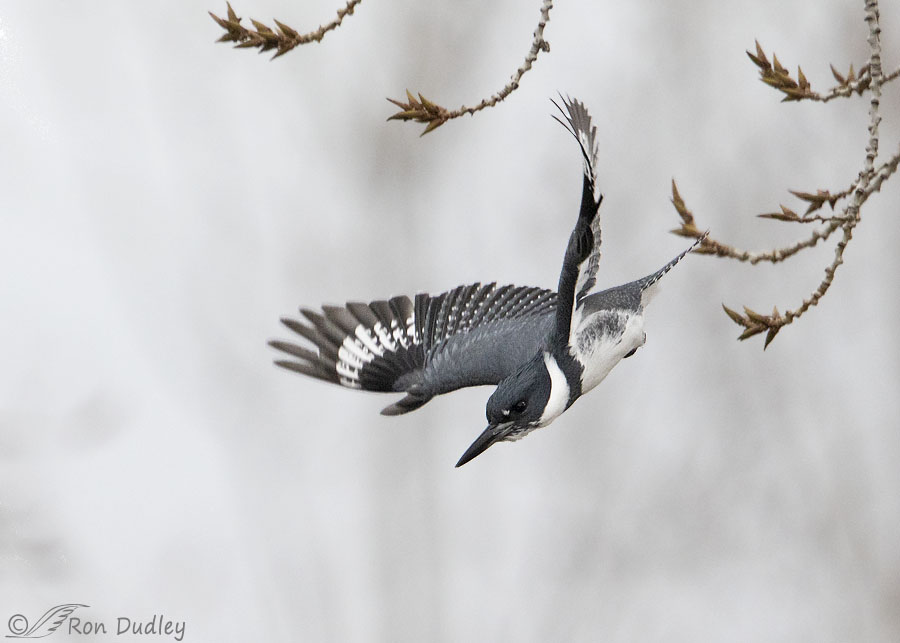I like both images but for different reasons.

1/3200, f/5.6, ISO 1250, Canon 7D Mark II, Canon EF 500mm f/4L IS II USM + EF 1.4 III Extender, not baited, set up or called in
This is the photo I posted yesterday. I’m only including it here to provide context for the next shot I took in the burst.
Despite the incredible speed of kingfisher takeoffs in a dive I managed to keep the bird in frame and in focus for one more photo after this one. Aesthetically I prefer this first shot but I think the next one is interesting for a couple of reasons.
1/4000, f/5.6, ISO 1250, Canon 7D Mark II, Canon EF 500mm f/4L IS II USM + EF 1.4 III Extender, not baited, set up or called in
In this shot the kingfisher had flown further away from the tree it had been perched in so the branches are less dominant than they are in the previous photo. I was disappointed that the end of his right wing was soft – at this shutter speed the softness certainly wasn’t caused by motion blur so at f/5.6 the culprit must have been depth of field. But studying the image reveals two things that I find interesting:
- As both a photographer and a biologist I’m always interested in precise indicators of how fast birds actually are. By comparing the two shots I can tell how far and what direction the kingfisher has traveled in exactly one tenth of a second (the burst rate of my camera is 10 frames/sec and these are consecutive photos). And since my focus point was inactive for both shots and the bird remained sharp in both of them that tells me that his forward motion was negligible during that tenth of a second. If he’d been flying toward me the second photo would have been soft.
- I have quite a few photos of birds in flight with one or both alulae, also known as “bastard wings”, deployed (separated from the wing) but I don’t remember ever seeing as much separation between alulae and wing as we see in this kingfisher’s right wing. For the vast majority of the time both alulae are held flush against the wing so they’re difficult if not impossible to see. Generally the alulae are only deployed during slow flight.
I hadn’t even noticed the alula in this second photo until last night so I’m glad I went back for a second look. I also have to wonder why the alula is deployed in the second photo but it isn’t in the first.
Ron
Notes on the alulae:
- Last I heard science still doesn’t know for sure if birds have control over alulae deployment or if they deploy automatically during wing action.
- “In most situations, the alula is held flush against the wing; however, it can be manipulated. When flying at slow speeds or landing, the bird moves its alula slightly upwards and forward, which creates a small slot on the wing’s leading edge. This functions in the same way as the slats on the wing of an aircraft, allowing the wing to achieve a higher than normal angle of attack – and thus lift – without resulting in a stall. The tip of the alula forms a tiny vortex that forces the airflow over the wing to better bind to it.” (Wikipedia)



So lovely.
Thanks, April.
“I also have to wonder why the alula is deployed in the second photo but it isn’t in the first.” It’s so he can screw up your DoF and make the primaries soft! (The little snot! 😉 )
I wouldn’t be surprised…
I just had to laugh at your use of the word deploy to describe movement of the alulae (although a totally appropriate choice). It reminds me of sci-fi movies: We’re being attacked, Captain! Deploy port alulae and fire a photon torpedo, Scotty.
Kidding aside, another characteristic I noticed from your previous Kingfisher photos is that they appear to flatten their spiky crest in flight. Perhaps another aerodynamic deployment?
Lyle, I actually thought of Captain Kirk while I was composing the post!
They also flatten their crest just before they take off in a dive. Without that signal all I’d probably get is “air shots” at takeoff.
Ron, very interesting lesson about the alulae and the comparison to an airplane wing. Too bad the Kingfisher didn’t get its fish…there’ll be a next time! Thank you for great photos.
Alice, I saw him dive on a fish three times and he missed every time.
Ron, these photos look like an Audubon painting! Simply beautiful. The Kingfishers seem to be making up for their elusive behavior by showing off for you!
Thanks, Melanie. I like that comparison.
I’m thinking of the physics of his dive. In order to turn his body that quickly he had to slow the right side relative to the left. The spread alula would give more air resistance on his right. DANG, I want wings to fly! signed bird obsessed in New Mexico.
“DANG, I want wings to fly! signed bird obsessed in New Mexico”
Ha, you’ll have to stand in line for that one, Mikal. Many of us here have the same strong desire.
Just beautiful.
Thank you.
Thanks, EC. How about a status report on your situation with the fires?
Our house is filled with smoke this morning. And we are the lucky ones. Over 12 million acres have burned this fire season. Many are still burning out of control. For the moment I am safe. Unlike so many others. I weep. I grieve. I rage.
I’m so very very sorry.
EC, Praying you stay safe. The fires are creating so much destruction, death and heartbreak. Thank you for the link on your blog about Mogo Zoo being saved, so far. Is there any way people in the US can help?
Thank you Melanie. At the end of that post there is a list of places where people can donate. And donations will certainly be needed in the coming weeks and months. We have firefighters from your country and Canada joining the fight – and they will be stretched to their limits.
E.C I am so sorry for the state your country is in. It is heart breaking the situation the people and animals are in. I hope the fires stop soon.
*swoon*
It just doesn’t get any better than this. At least not for me.
Good. Thank you, Leslie.
That’s a fascinating tree – knobby small branches with significant thorns. What is it?
I don’t think they’re thorns but I don’t know what kind of tree it is, Sallie.
I think the answer to the alulae deployment lies in your post of yesterday “after he dove on a fish (which he missed).” He was cutting an angle as hard as he could to get to that fish, which raised the alulae to put move t that angle. It still wasn’t enough for him to make the catch.
I don’t see any damage to the feathers in those tiny winglets.
Pam, you could be right but he was a long way above the water at that point. I think he was just trying to maneuver through the branches so his wings didn’t hit them. But who knows…
They DO move out and, generally, NOT in the direction we would prefer! 😉 The alulae appeared to deploy with the rest of the right wing feathers flaring out – obviously there is a “reason”…..;) Noted a bit of “broken” feather on the left wing near the alulae in both photos – guessing it has nothing to do with the alulae tho. Always something to learn and/or ponder!
“generally, NOT in the direction we would prefer”
Classic understatement, Judy. 🙂
Good early morning Ron. Typing this at 5:27 am as I get ready to head out to be a participant from 7 to 11 am in our annual Bald Eagle count. I did it last year when we counted 9 at Goldwater Lake where I will stationed with one of our local bird experts. I think we have 24 people involved who will take up positions at all our Prescott lakes followed by brunch courtesy of the USFS. Thought I was going to freeze to death last year, but this year’s forecast is much more favorable. I believe all those involved are Audubon members
Very interesting post that has given me a quick photography lesson as well as a biology one. Thanks for posting this and again using one of my favorite birds.
Thanks, Everett. Good luck with your eagles today. Keep warm!
Love them both and am envious because I know how fast they move! I have so many blank or just bits of feathers in my second photo of this bird! And very interesting. I’ve never seen that separation…always thought it just rested there on top. Another marvel with nature that teaches man ‘how it works’. We could learn so much more in so many other aspects of life also.
Hell, Kathy – I often get “blanks or just bits of feathers” in my FIRST photo of this species during a diving takeoff! I’m always amazed by how fast they are.
Good morning! I agree that the first shot is more pleasing both technically and aesthetically. It seems to better tell the “story” of where the bird came from as well as where he may be going. The subtle nuances of photos like these, demonstrate our feathered friends true mastery of ‘Leaving the bounds of earth” and how primitive mans ability still is. Very interesting perspective in just a 1/10 of a second! Have a GREAT DAY!
Thanks, Tom. I see you’re an early bird too…